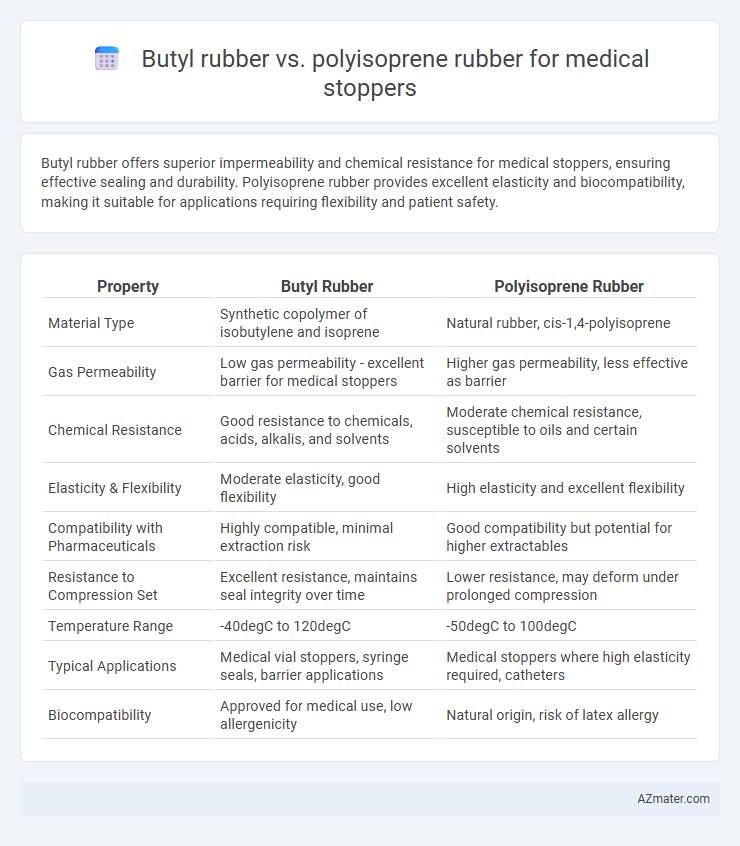Butyl rubber offers superior impermeability and chemical resistance for medical stoppers, ensuring effective sealing and durability. Polyisoprene rubber provides excellent elasticity and biocompatibility, making it suitable for applications requiring flexibility and patient safety.
Table of Comparison
| Property | Butyl Rubber | Polyisoprene Rubber |
|---|---|---|
| Material Type | Synthetic copolymer of isobutylene and isoprene | Natural rubber, cis-1,4-polyisoprene |
| Gas Permeability | Low gas permeability - excellent barrier for medical stoppers | Higher gas permeability, less effective as barrier |
| Chemical Resistance | Good resistance to chemicals, acids, alkalis, and solvents | Moderate chemical resistance, susceptible to oils and certain solvents |
| Elasticity & Flexibility | Moderate elasticity, good flexibility | High elasticity and excellent flexibility |
| Compatibility with Pharmaceuticals | Highly compatible, minimal extraction risk | Good compatibility but potential for higher extractables |
| Resistance to Compression Set | Excellent resistance, maintains seal integrity over time | Lower resistance, may deform under prolonged compression |
| Temperature Range | -40degC to 120degC | -50degC to 100degC |
| Typical Applications | Medical vial stoppers, syringe seals, barrier applications | Medical stoppers where high elasticity required, catheters |
| Biocompatibility | Approved for medical use, low allergenicity | Natural origin, risk of latex allergy |
Introduction to Medical Stoppers
Medical stoppers require exceptional sealing properties, chemical resistance, and biocompatibility to ensure the safety and integrity of pharmaceuticals. Butyl rubber offers superior impermeability to gases and excellent resistance to chemicals, making it a preferred choice for long-term storage in medical stoppers. Polyisoprene rubber provides elasticity and a natural feel with good biocompatibility but shows comparatively lower resistance to permeation and chemical exposure in critical medical applications.
Overview of Butyl Rubber
Butyl rubber is a synthetic elastomer known for its excellent impermeability to gases, making it a preferred material for medical stoppers that require airtight sealing. Its superior chemical resistance, low moisture vapor transmission rate, and strong elasticity ensure durability and safety in pharmaceutical applications. Compared to polyisoprene rubber, butyl rubber offers enhanced barrier properties crucial for maintaining the sterility and stability of injectable medications.
Overview of Polyisoprene Rubber
Polyisoprene rubber, a synthetic alternative to natural rubber, offers excellent elasticity, high tensile strength, and superior biocompatibility, making it ideal for medical stoppers requiring flexibility and durability. Unlike butyl rubber, polyisoprene provides enhanced oxygen permeability and improved sensory properties, essential for applications involving fluid containment and repeated puncturing by needles. Its hypoallergenic nature and resistance to sterilization methods such as autoclaving and gamma radiation further establish polyisoprene as a preferred material in medical device manufacturing.
Material Properties: Butyl vs Polyisoprene
Butyl rubber exhibits exceptional impermeability to gases and moisture, making it ideal for medical stoppers requiring airtight seals and chemical resistance. Polyisoprene rubber offers superior elasticity and biocompatibility, closely mimicking natural rubber's flexibility and tactile properties while maintaining hypoallergenic qualities. The choice between butyl and polyisoprene for medical stoppers hinges on balancing barrier performance with mechanical flexibility and patient safety standards.
Chemical Resistance Comparison
Butyl rubber exhibits exceptional chemical resistance against polar solvents, weak acids, and bases, making it ideal for medical stoppers exposed to pharmaceuticals and aqueous solutions. Polyisoprene rubber offers moderate resistance but tends to swell or degrade when in contact with oils, fuels, and strong acids, limiting its use in aggressive chemical environments. The superior impermeability and chemical stability of butyl rubber ensure longer service life and reliability in medical sealing applications.
Barrier Performance in Medical Applications
Butyl rubber exhibits superior gas barrier properties compared to polyisoprene rubber, making it ideal for medical stoppers where maintaining sterility and preventing gas permeability are critical. Polyisoprene rubber offers excellent elasticity and biocompatibility but has higher oxygen and moisture permeability, reducing its effectiveness as a barrier in sensitive medical applications. Selecting butyl rubber for medical stoppers enhances product shelf life and protects drug formulations from contamination and degradation.
Biocompatibility and Safety Profiles
Butyl rubber exhibits superior biocompatibility and excellent gas impermeability, making it a preferred choice for medical stoppers that require long-term pharmaceutical stability. Polyisoprene rubber closely mimics natural rubber latex properties, offering enhanced elasticity and comfort but may pose allergenic risks due to residual proteins. The safety profile of butyl rubber is well-established with minimal extractables and leachables, while polyisoprene requires thorough testing to ensure compatibility and reduce potential adverse reactions in medical applications.
Processing and Manufacturing Considerations
Butyl rubber offers superior chemical resistance and low gas permeability, making it ideal for medical stoppers requiring extended shelf life and sterilization compatibility. Polyisoprene rubber, with its excellent elasticity and natural rubber-like properties, allows for easier molding and precise dimensional control during manufacturing, enhancing stopper performance and sealing. Processing butyl rubber requires specialized curing methods to optimize its impermeability, while polyisoprene benefits from conventional vulcanization, providing manufacturing flexibility and cost efficiency.
Cost Analysis: Butyl vs Polyisoprene Rubber
Butyl rubber offers a cost advantage over polyisoprene rubber due to lower raw material prices and simpler manufacturing processes, making it a preferred choice for budget-sensitive medical stopper production. Polyisoprene rubber, however, incurs higher expenses driven by greater material costs and more complex curing requirements, impacting overall production costs. Evaluating total lifecycle expenses, including durability and chemical resistance, is essential for accurate cost-benefit analysis in medical applications.
Choosing the Right Rubber for Medical Stoppers
Butyl rubber offers superior impermeability to gases and excellent chemical resistance, making it ideal for maintaining the sterility and integrity of medical stoppers. Polyisoprene rubber, with its high elasticity and biocompatibility, provides exceptional sealing performance, especially in applications requiring a softer, flexible material. Choosing the right rubber depends on the specific requirements for barrier properties, elasticity, and chemical compatibility to ensure optimal performance in medical stopper applications.

Infographic: Butyl rubber vs Polyisoprene rubber for Medical stopper
 azmater.com
azmater.com